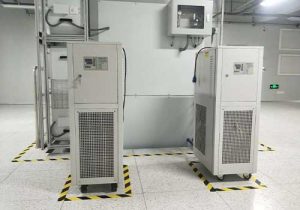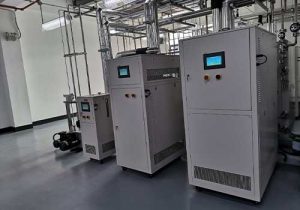working of chillers
Chillers are sophisticated devices that utilize the refrigeration cycle to remove heat from a fluid, making them essential for cooling processes, equipment, or spaces across various sectors. Their operation hinges on the ability to transfer heat from a low-temperature source (the fluid to be cooled) to a high-temperature sink (the environment), facilitated by a refrigerant that alternates between liquid and gaseous states.

The fundamental working process of a chiller revolves around four key stages of the refrigeration cycle: evaporation, compression, condensation, and expansion. Each stage is enabled by specific components that work in sequence to achieve continuous cooling.
The evaporation stage takes place in the evaporator, a heat exchanger where the refrigerant and the fluid to be cooled (chilled water or glycol mixture) interact. The refrigerant enters the evaporator as a low-pressure, low-temperature liquid. As the warm fluid flows around or through the evaporator coils, heat from the fluid is transferred to the refrigerant. This heat absorption causes the refrigerant to boil and vaporize, transforming into a low-pressure gas. The fluid, now cooled, exits the evaporator and is pumped to the area or equipment needing cooling, where it absorbs more heat before returning to the evaporator to repeat the cycle.
Following evaporation, the low-pressure refrigerant gas is drawn into the compressor. The compressor’s primary function is to increase the pressure of the gas, which in turn raises its temperature significantly. By compressing the gas, its molecules are packed closer together, elevating its thermal energy. This high-pressure, high-temperature gas is crucial for the next stage, as it needs to be hotter than the environment to release heat efficiently.
The compressed refrigerant gas then moves to the condenser, another heat exchanger responsible for heat rejection. In this stage, the high-temperature refrigerant transfers its heat to a cooling medium—either air (in air-cooled chillers) or water (in water-cooled chillers). In air-cooled condensers, fans blow ambient air over the condenser coils, and the heat from the refrigerant is dissipated into the air. In water-cooled condensers, a separate stream of cooling water (often from a cooling tower) circulates through the condenser, absorbing the heat, which is then released into the atmosphere via the cooling tower. As the refrigerant loses heat, it condenses back into a high-pressure liquid.

The high-pressure liquid refrigerant proceeds to the expansion valve (or metering device), which acts as a restriction in the system. This restriction reduces the pressure of the refrigerant as it passes through the valve, causing a rapid drop in temperature. The refrigerant emerges from the expansion valve as a low-pressure, low-temperature mixture of liquid and vapor, ready to re-enter the evaporator and restart the cycle.
Key components beyond the core four stages enhance the chiller’s functionality. Pumps circulate the cooled fluid through the system, ensuring a steady flow from the evaporator to the cooling load and back. In larger systems, variable speed pumps adjust their flow rate based on cooling demand, optimizing energy use. Refrigerant filters and driers remove contaminants and moisture from the refrigerant, preventing damage to components like the compressor.
Control systems regulate the chiller’s operation to maintain desired temperatures and efficiency. Sensors monitor the temperature of the cooled fluid (supply and return), refrigerant pressure, and ambient conditions. These sensors feed data to a controller, which adjusts the compressor’s output, fan speed (in air-cooled models), or water flow (in water-cooled models) to match the cooling demand. For example, if the cooled fluid’s return temperature is lower than the setpoint, the controller may reduce the compressor’s capacity to avoid over-cooling and save energy.
Chillers are categorized primarily by their heat rejection method: air-cooled and water-cooled, each with distinct operational characteristics.
Air-cooled chillers use ambient air as the cooling medium in the condenser. They feature condenser coils with fins to increase surface area, and fans that force air over these coils to dissipate heat from the refrigerant. This design eliminates the need for a separate cooling water system, simplifying installation and reducing maintenance requirements. However, their efficiency is heavily influenced by ambient temperature—higher air temperatures reduce the temperature difference between the refrigerant and the air, making heat transfer less efficient. They are commonly used in small to medium-sized applications, such as commercial buildings, where space and water availability are limited.

Water-cooled chillers rely on water (typically from a cooling tower) to cool the condenser. The condenser transfers heat from the refrigerant to the cooling water, which is then pumped to a cooling tower. At the cooling tower, heat is released into the atmosphere through evaporation, and the cooled water is recirculated back to the condenser. Water’s superior heat transfer capability allows water-cooled chillers to operate more efficiently than air-cooled ones, especially in large-scale applications. They are ideal for industrial facilities, hospitals, and large commercial complexes but require additional infrastructure (cooling tower, water pumps, and treatment systems) and more maintenance.
Other chiller types, classified by their compressor design, also exhibit operational differences. Reciprocating chillers use piston-driven compressors, suitable for medium cooling loads and offering good efficiency at full load. Screw chillers employ rotating helical screws to compress the refrigerant, handling larger loads and providing better part-load efficiency. Scroll chillers, with interlocking spiral compressors, are known for quiet operation and high efficiency in small to medium applications. Centrifugal chillers use rotating impellers to compress refrigerant, making them suitable for very large cooling loads, such as in data centers or industrial plants.
Several factors influence the efficiency and performance of chillers. The temperature difference (ΔT) between the cooled fluid’s supply and return is critical—a larger ΔT indicates the fluid is absorbing more heat, reducing the required flow rate and energy consumption. Refrigerant type affects both efficiency and environmental impact; modern chillers use low-global-warming-potential (GWP) refrigerants like R-134a or R-410A, replacing older, more harmful options.
Compressor efficiency is another key factor. Variable speed compressors, which adjust their speed based on demand, are more efficient than fixed-speed models, especially at part load. Proper maintenance, such as cleaning evaporator and condenser coils to remove dirt and debris, ensures optimal heat transfer. Dirty coils act as insulators, reducing efficiency and forcing the compressor to work harder.
Refrigerant charge is also vital. An undercharged system reduces cooling capacity, while overcharging can increase energy consumption and damage components. Regular leak checks and refrigerant level adjustments are necessary to maintain performance.
Water quality is crucial for water-cooled chillers. Poor water quality can lead to scaling, corrosion, or biological growth in the condenser and cooling tower, impairing heat transfer and shortening equipment life. Water treatment, including the use of corrosion inhibitors, biocides, and scale reducers, is essential to preserve system integrity.
In summary, chillers operate through a cyclic refrigeration process that involves evaporation, compression, condensation, and expansion, with components working in harmony to cool a fluid. Their design—whether air-cooled, water-cooled, or based on a specific compressor type—dictates their efficiency, maintenance needs, and suitability for different applications. Understanding their working principles allows for informed selection, operation, and maintenance, ensuring reliable and efficient cooling in diverse settings.
Related recommendations
The Difference between Open Chiller and Water-cooled Box Chiller
1741The Difference between Open Chiller and Water-cooled Box Chiller Everyone knows that chillers can be classified in various and complicated ways. It is mainly divided into two types: air-coole...
View detailswater cooler cooling system
404Water Cooler Cooling Systems: An Overview Water cooler cooling systems, more commonly known as water chillers, are essential in a variety of applications where temperature control is necessary....
View detailsWhat is the reason why the medical chillers fan does not operate?
1091What is the reason why the medical chillers fan does not operate? Refrigeration equipment is applied to CNC machine tools, coordinate boring machines, grinders, machining centers, modul...
View detailsConcentration Selection of Brine for Low Temperature Chiller
1354Concentration Selection of Brine for Low Temperature Chiller The brine solution has a lower condensation temperature, so it can be often used in medium-temperature and low-temperature chille...
View details
 LNEYA Chiller
LNEYA Chiller







HelloPlease log in